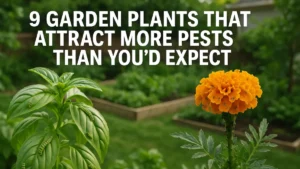Gardening can be a rewarding experience, but even the most beautiful plants may come with hidden challenges. While many plants are praised for their ability to repel pests, some of the most beloved garden species can actually attract more bugs than you might expect.
From bright marigolds to fragrant lavender, certain plants that gardeners adore can become magnets for unwanted pests. Aphids, caterpillars, and beetles can target these plants, damaging their leaves, stems, and flowers. In this blog, we’ll dive into 9 common garden plants that tend to attract pests and what you can do to manage these pesky visitors.
1. Marigolds
Marigolds are often touted as natural pest repellents, but they can also attract pests under certain conditions. These bright, cheerful flowers, which are commonly planted to deter aphids, whiteflies, and nematodes, can become a magnet for other insects.
Aphids, in particular, are drawn to the tender new growth of marigolds, where they can easily feed. Marigolds’ sticky sap can also attract ants, which protect aphids for their honeydew secretion.
Additionally, the scent of marigold flowers, which is known to repel certain pests, might not be strong enough to keep away other garden invaders like slugs, snails, and beetles. While marigolds are a great companion plant in gardens, their appeal to some pests should not be underestimated.
2. Sunflowers
Sunflowers are a favorite among gardeners for their height and vibrant appearance, but they can attract more pests than you might expect. The large, colorful blooms are a favorite target for aphids, which cluster on the undersides of leaves, feeding on the plant’s sap and potentially transmitting harmful plant diseases.
Additionally, sunflower seeds, which are often harvested or enjoyed by wildlife, can attract birds and rodents, who may feed on them or damage the plants in the process. Sunflowers are also susceptible to the sunflower beetle, which feeds on the leaves and flowers, and the larvae can cause significant damage if left unchecked.
While sunflowers are great for attracting pollinators, their popularity with various pests makes them a more challenging plant to manage in your garden.
3. Nasturtiums
Nasturtiums are known for their vibrant flowers and ease of care, but these plants can attract pests as well. While they are often used to deter aphids and other harmful insects from other plants, they can also become a target themselves.
Aphids, in particular, are drawn to the young growth of nasturtiums, and the plants may suffer from infestations if not monitored carefully. In addition, nasturtiums can attract caterpillars, which feed on the leaves and flowers, leaving behind holes and reducing the plant’s overall beauty.
Another common pest that targets nasturtiums is the whitefly, which can cause damage by sucking the sap from the plant. Despite their pest-attracting tendencies, nasturtiums can still be a beneficial addition to a garden when carefully managed.
4. Petunias
Petunias are popular garden flowers that are often praised for their beauty and low-maintenance nature, but they can also attract pests. These fragrant blooms can become a hotspot for aphids, especially when the plants are stressed or under attack from other pests.
Aphids can weaken petunias by feeding on the sap, which can also lead to the development of sooty mold. Another pest commonly found on petunias is the tobacco hornworm, a large green caterpillar that can quickly decimate the plant by feeding on its leaves.
Additionally, petunias can attract spider mites, which feed on the undersides of leaves, causing them to yellow and curl. Although petunias can add color to any garden, gardeners should be prepared to deal with the potential pest problems they bring.
5. Roses
Roses are beloved for their beauty and elegance, but they can attract a wide range of pests that are difficult to manage. Aphids are perhaps the most common pest found on rose plants, feeding on the tender new growth and leaving behind sticky honeydew that can promote mold growth.
In addition to aphids, roses are also susceptible to Japanese beetles, which eat the leaves, petals, and buds, often leaving the plant severely damaged. Rose slugs, caterpillar-like larvae, can also cause extensive damage by eating the foliage, leaving it skeletonized.
Additionally, roses can attract spider mites, thrips, and various fungi, all of which can lead to a decline in plant health. While roses are undeniably beautiful, they require regular pest control to keep them thriving in the garden.
6. Dahlias
Dahlias are another popular flowering plant, known for their striking blooms and variety of colors, but they can also attract a significant number of pests. Slugs and snails are particularly fond of dahlias, especially when the plants are young and their stems are tender.
These pests can cause considerable damage by eating the leaves and flowers, often leaving behind slimy trails. In addition to mollusks, dahlias can attract aphids, which feed on the plant’s sap and can lead to stunted growth and a weakened plant.
Another common pest is the dahlia tuber borer, whose larvae burrow into the tubers, causing extensive damage that can kill the plant. While dahlias are stunning in the garden, they do require diligent monitoring to prevent pest infestations from taking hold.
7. Zinnias
Zinnias are cheerful and colorful flowers that are often planted to attract butterflies, but they can also attract a variety of pests. These vibrant flowers are particularly vulnerable to aphids, which feed on the sap of the plant, potentially stunting growth and causing the leaves to yellow and curl.
Zinnias can also attract spider mites, which suck the sap from the undersides of leaves, leading to damage and discoloration. In addition, zinnia plants can suffer from powdery mildew, a fungal disease that thrives in humid conditions and weakens the plant.
Caterpillars, including the larval stage of moths, may also feed on the leaves, leaving large holes and affecting the plant’s overall health. While zinnias are beautiful additions to any garden, gardeners should be prepared to tackle the pests that often target these hardy plants.
8. Lavender
Lavender is a favorite for its fragrant aroma and ability to repel some pests, but it is not immune to being targeted by other garden invaders. While lavender tends to deter insects like mosquitoes and flies, it can also attract pests like aphids, especially when the plants are stressed.
Aphids can be found on the undersides of lavender leaves, feeding on the sap and potentially weakening the plant. Lavender is also susceptible to fungal infections like lavender root rot, which is often caused by poor drainage and can attract fungal gnats.
Additionally, the lavender plant can attract the common whitefly, which feeds on the plant’s leaves and can lead to stunted growth and discoloration. Lavender requires specific care to prevent pest infestations, despite its reputation for pest-repellent qualities.
9. Tomatoes
Tomatoes are one of the most commonly grown vegetables, but they can attract a variety of pests that can severely impact plant health. Aphids, which are notorious for spreading diseases like mosaic virus, can infest tomato plants, causing leaves to curl and yellow.
Another common pest is the tomato hornworm, a large caterpillar that feeds on the plant’s leaves, flowers, and fruit, often causing extensive damage. Whiteflies can also target tomato plants, feeding on the sap and leading to yellowing leaves and weakened growth.
Additionally, tomatoes are prone to issues with nematodes, tiny worms that attack the roots, making the plant more susceptible to disease. Regular pest monitoring and management are essential to maintaining healthy tomato plants in the garden.
Bottom Line
While many garden plants have the potential to attract pests, understanding which plants are most vulnerable and how to manage them can help maintain a healthy garden. Regular monitoring, pest control, and proper plant care are essential to keeping your plants thriving despite these challenges. By taking proactive steps, you can still enjoy the beauty of these plants without them becoming a pest magnet.
FAQs
Why do certain plants attract more pests?
Certain plants attract pests due to their soft, tender leaves or sweet nectar, which act as a food source for insects like aphids and caterpillars.
Can I prevent pests on my plants naturally?
Yes, using organic pest control methods like neem oil, insecticidal soap, or encouraging natural predators (like ladybugs) can help reduce pest infestations.
Are marigolds really good at repelling pests?
Marigolds are known to repel some pests, but they can still attract aphids and other insects, especially if the plants are stressed.
How can I protect my tomatoes from pests?
Regularly check for pests like aphids and hornworms, and use organic insecticides or physical barriers like netting to keep pests away from your tomato plants.



